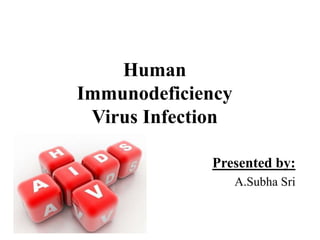HIV
- 2. ?ETHIOLOGY: ? Acquired immunodeficiency syndrome (AIDS) is caused by Human Immuno Deficiency Virus (HIV). ? HIV is a member of genus Lentivirus & it is a single stranded RNA retrovirus
- 3. ?Forms of HIV: M (main) N (new) O (outlier ) HIV-1 HIV-2 HIV A to D F to H J K SUBTYPES SEROLOGICAL TYPES
- 5. ?EPIDEMIOLOGY: ? In 1981 - 30 million people have died as a result of HIV infection. ? In 2009 - HIV infected approximately 33 million people worldwide (East Asia, Central Asia, and Eastern Europe). ? In 2009 - approximately 1.8 million people died from AIDS and 2.6 million people were newly infected with HIV.
- 6. ? HIV-1, the most prevalent worldwide, and ? HIV-2, the most common in western Africa. ? HIV-1 subtype B is primarily responsible for the North American and Western European epidemic. ?EPIDEMIOLOGY:
- 7. ?Mode Of Transmission: ? HIV infection occurs through three primary modes of transmission: sexual, parenteral, and perinatal.
- 9. ?DIAGNOSIS: ? HIV diagnosis is made either ? Initial Screening Tests: ELISA HIV RNA assay ? Confirmatory Tests: Western blot (WB) Indirect immunofluorescence assay (IFA) ? CD4+ cell count ? Viral Load
- 10. ?CLINICAL PRESENTATION: ? Patients with acute HIV infection may display symptoms described as Ī░acute retroviral syndrome.Ī▒ ? Patients with chronic HIV infection may present with these same nonspecific symptoms and/or opportunistic infections. Acute Retroviral Syndrome The majority of patients may present with fever, lymphadenopathy, pharyngitis, and/or rash.
- 11. Other symptoms include: ? Myalgia or arthralgia ? Diarrhea ? Headache ? Nausea and vomiting ? Hepatosplenomegaly ? Weight loss ? Thrush ? Neurologic symptoms (meningoencephalitis, aseptic meningitis, peripheral neuropathy, facial palsy, or cognitive impairment or psychosis) ?CLINICAL PRESENTATION:
- 12. ?TREATMENT Goals of treatment are ? To maximally and durably suppress viral replication, ? Avoid the development of drug resistance, ? Restore and preserve immune function, ? Prevent opportunistic infections, and ? Minimize drug adverse effects.
- 13. ?HAART ©C Highly Active Anti Retroviral Therapy ? Six classes of drugs are available to treat HIV infection: (a) Nucleoside reverse transcriptase inhibitors (NRTIs): Zidovudine (AZT), Didanosine, Stavudine, Lamivudine, Abacavir, Emtricitabine, Tenofovir (Nt RTI) (b) Nonnucleoside reverse transcriptase inhibitors (NNRTIs): Nevirapine, Efavirenz, Delavirdine
- 14. (c) Protease inhibitors: Ritonavir, Atazanavir, Indinavir, Nelfinavir, Saquinavir, Amprenavir, Lopinavir (d) Entry (Fusion) inhibitor: Enfuvirtide (e) CCR5 receptor inhibitor: Maraviroc (f) Integrase inhibitor: Raltegravir
- 15. DRUG DOSAGE FORMS ADVERSE EFFECTS I) Nucleoside (tide) Reverse Transcriptase Inhibitors: Abacavir (Ziagen) 300-mg tablet; 20 mg/mL oral solution Potentially fatal hypersensitivity reaction (rash, fever, malaise, nausea,vomiting, shortness of breath, sore throat, loss of appetite) Didanosine (Videx EC) 125-, 200-, 250-,400-mg capsules Pancreatitis; peripheral neuropathy; nausea;diarrhea Emtricitabine (Emtriva) 200-mg capsule; 10 mg/mL oral solution Minimal Lamivudine (Epivir) 150-mg and 300-mg tabs or 10 mg/mL oral solution Minimal Stavudine (Zerit) 15-, 20-, 30-, 40-mg capsules or 1 mg/mL for oral Solution Peripheral neuropathy; rapidly progressive ascending neuromuscular weakness (rare); pancreatitis; lactic acidosis with hepatic steatosis (higher incidence with stavudine than with other NRTIs); Hyperlipidemia.
- 16. DRUG DOSAGE FORMS ADVERSE EFFECTS Tenofovir (Viread) 300-mg tablet Asthenia, headache, diarrhea, nausea, vomiting, and flatulence; renal insufficiency Zidovudine (Retrovir) 100-mg capsule, 300- mg tablet, 10 mg/mL IV solution, 10 mg/mL oral solution Bone marrow suppression: macrocytic anemia or neutropenia; GI intolerance, headache, insomnia, II) Nonnucleoside Reverse Transcriptase Inhibitors Delavirdine (Rescriptor) 100-, 200-mg Tablets Rash; increased LFTs, headaches Efavirenz (Sustiva) 50-, 100-, 200-mg capsules or 600- mg tablet Rash; CNS symptoms (insomnia, irritability, lethargy, dizziness, vivid dreams) usually resolve in 2 weeks. Etravirine (Intelence) 100-, 200-mg tablets Rash, nausea Nevirapine (Viramune) 200-mg tablet or 50 mg/5 mL oral suspension Rash including Stevens-Johnson syndrome;symptomatic hepatitis, including fatal hepatic necrosis
- 17. DRUG DOSAGE FORMS ADVERSE EFFECTS Rilpivirine (Edurant) 25-mg tablet Rash; depressive disorders; III) Protease Inhibitors Atazanavir (Reyataz) 100-, 150-, 200-, 300-mg capsules Indirect hyperbilirubinemia; prolonged PR interval hyperglycemia; fat maldistribution; increased bleeding episodes in patients with hemophilia Darunavir (Prezista) 400-, 600-mg tablets Skin rash ; diarrhea, nausea; headache; hyperlipidemia; hyperglycemia; fat maldistribution Fosamprenavir (Lexiva) 700-mg tablet; 50 mg/mL oral suspension Skin rash; diarrhea, nausea and vomiting; headache; hyperlipidemia; LFT elevation; hyperglycemia; fat maldistribution; increased bleeding episodes in patients with hemophilia Indinavir (Crixivan) 200-, 333-, 400-mg capsules GI intolerance, nausea; indirect hyperbilirubinemia; hyperlipidemia; headache, asthenia, blurred vision, dizziness, rash, metallic taste, thrombocytopenia, alopecia, hemolytic anemia; hyperglycemia.
- 18. DRUG DOSAGE FORMS ADVERSE EFFECTS Nelfinavir (Viracept) 250©C625-mg tablets, 50 mg/g oral powder Diarrhea; hyperlipidemia; hyperglycemia; fat maldistribution; increased bleeding in hemophiliacs; LFT elevation Ritonavir (Norvir) 100-mg tablet, 600 mg/7.5-mL solution GI intolerance, nausea, diarrhea; paresthesias; hyperlipidemia; hepatitis; asthenia; taste perversion; hyperglycemia; fat maldistribution; increased bleeding in hemophiliacs IV) Fusion Inhibitors Enfuvirtide (Fuzeon) Injectable, in lyophilized powder. Each single use vial contains 108 mg of enfuvirtide to be reconstituted with 1.1 mL of sterile water for injection for delivery of Approx. 90mg/1mL Local injection site reaction (pain, erythema, induration, nodules and cysts,pruritus, eachymosis) in most patients; increased rate of bacterial pneumonia; less than 1% Hypersensitivity reaction (rash,fever, nausea, vomiting, chills, rigors, hypotension, or elevated serum transaminases); do not rechallenge
- 19. DRUG DOSAGE FORMS ADVERSE EFFECTS V) Chemokine Receptor Antagonists (CCR5 Antagonists) Maraviroc (Selzentry 150-mg and 300- mg tablets Abdominal pain; cough; dizziness; Musculoskeletal symptoms; pyrexia; rash; upper RTI; hepatotoxicity; Orthostatic hypotension VI) Integrase Inhibitors Raltegravir (Isentress) 400-mg tablet Nausea; headache; diarrhea; pyrexia; CPK elevation
- 23. ?COMBINATIONS TO BE AVOIDED:
- 24. ?PREVENTION: ? Protected sex. ? Avoiding sex with multiple partners. ? Care should be taken during blood transfusion.
- 25. THANK YOU
























